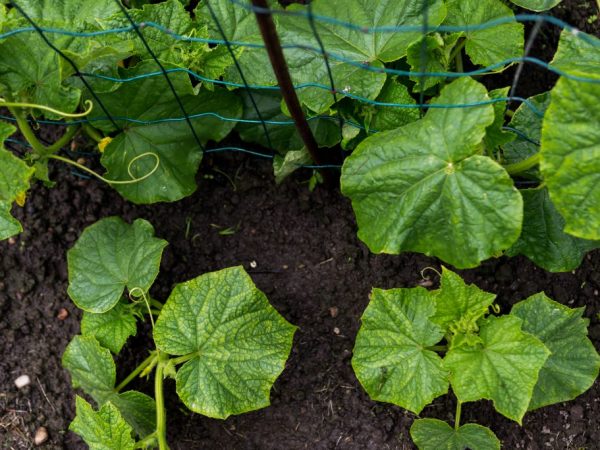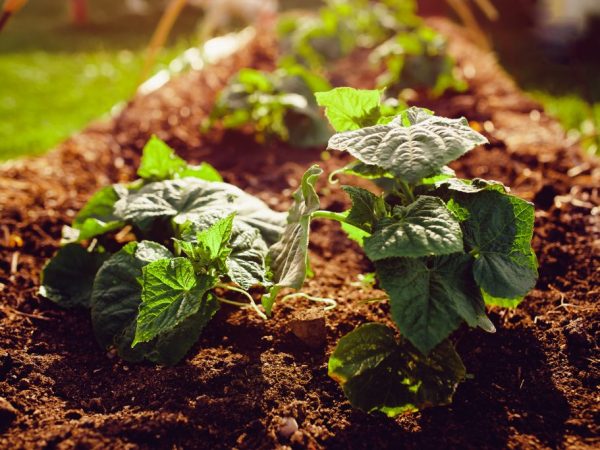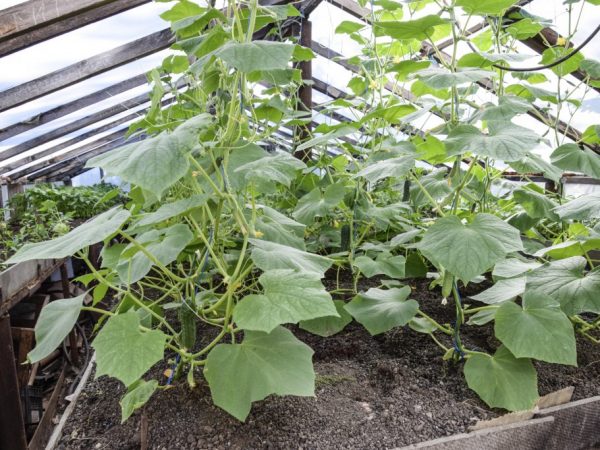How to prepare the soil for cucumbers before planting
Preparing the soil for cucumbers is the first step in growing this crop.

Preparing the soil for cucumbers
It is very important to choose the right land, its location. Fertilizers are also needed. Let's consider the features of preparation in more detail.
Soil requirements
First you need to choose the area where the cucumbers will grow. It is desirable that it be turned to the south, because these vegetables love a sunny place without drafts. It is necessary to take into account what previous crops were grown here. It's good if it was potatoes, tomatoes, cauliflower, root vegetables, legumes. You should not plant greens in the place where zucchini, squash, eggplants grew. After them, microorganisms accumulate in the soil, which then lead to plant diseases.
The land for planting cucumbers should be:
- loose;
- structured;
- fertile.
Therefore, in open areas, it is better to choose light loamy or sandy soils that have good water permeability. It is important that they contain a large amount of humus. Cold peat bog soils are considered completely unsuitable for growing cucumbers. They contain little phosphorus, potassium, magnesium and other trace elements. The peat land warms up slowly in the spring and cools quickly in the fall.
Acceptable soil acidity for cucumbers 6-7 units. At a pH level of 6-6.1 units, the greatest return of the plant is observed. After all, such indicators of acidity contribute to the formation of the maximum number of female flowers.
Cucumbers prefer moist soil and therefore require frequent watering. 75-85% soil moisture is optimal for crop cultivation.
The temperature of the soil before planting cucumbers is also important. It should be approximately equal to the air temperature or lower by 2-3˚С. The best indicator for seed germination is 25-28 ° C, at which seedlings appear in 3 days. At temperatures below 14 ° C, the culture stops growing. Indicators above 40˚C will be critical.
Autumn soil preparation
Preparing the soil for cucumbers can begin in the fall.
Digging
After harvesting, it is necessary to remove plant residues and weeds from the site. If pests raged in the garden, it is worth digging up the ground. Then the beetles, larvae that hit the surface will die during the winter, and the mice will leave the site. Autumn digging is also carried out if the soil is heavy, compacted and there is a danger of trapping snow on it. Prolonged springs with slow soil warming are an excuse for such events.
Do not touch the ground in the following cases:
- plot with a slope;
- flood-prone area;
- light soils prone to erosion.
Liming
It is necessary to determine the pH level. This can be done using a special device or in the laboratory. If this is not possible, use litmus paper. To do this, take soil with a shovel from a depth of 30 cm.In a fist, they squeeze it with paper, by the color of which acidity is determined.
Also the indicator of the pH level is the plants that are on the site. If it is plantain, horsetail, Veronica Dubravnaya, pickulnik, sedge, horse sorrel, mint, creeping buttercup, wood lice, then the earth is sour. Wheatgrass, field bindweed, coltsfoot, garden thistle, odorless chamomile and clover indicate non-acidic soil or with a low acidity.
To neutralize the elevated pH level, liming is carried out with such substances as slaked lime, ash, dolomite flour, chalk, cement ash. This procedure is carried out every 4-5 years.
Organic feed
To saturate the soil with useful microelements, top dressing is done in the fall. After all, the root system of zelents is superficial and quickly absorbs substances. Organic matter, decomposing, becomes a source of carbon dioxide, which is necessary for the growth of vegetables. If the acidity of the soil is low, liquid alkaline fertilizers should be used.

The plant needs nutrients
Preparing the soil for cucumbers can be continued with the introduction of fresh manure in the fall. It will help loosen heavy clay soils and bind sandy soils. It contains nitrogen, potassium, phosphorus, calcium. Substance consumption - per 1 sq. m. from 6 to 9 kg. If the soil is light, you need to bring in less, heavy - more. Fresh manure should not be used at the same time as lime. They react in which nitrogen is lost.
Ash is a good source of potassium and other nutrients. It is brought in at the rate of 200 g per 1 sq. m. It is also good to use compost for fertilizers.
Mulching
The effect of preparing the soil for cucumbers will be much higher if you cover its fertile layer. Mulch can be prepared from sawdust, straw, tree leaves, sunflower husks, grass. Birch leaves will be useful.
Each layer of mulch is sprinkled with earth. Some organic matter decomposes before spring. Mulching is well done on structural soils, so that plant roots can easily grow into it.
Spring soil preparation
If it was not possible to improve the beds in the fall, it must be done in the spring. Lime substances should not be added; liquid alkaline organic fertilizers can be used. They dig up the soil, deepening the shovel by 25-30 cm.
Spread a layer of 12 cm with a rake, mixing it with a lot of humus. It is prepared using sawdust, dried grass, fallen leaves, straw, manure, pieces of paper, etc. The bed is moistened and covered with a film so that the earth warms up. These activities are performed a few days before planting the culture.
The soil for cucumbers, dug up and fertilized in the fall, should be loosened in the spring. It is necessary to scatter humus on the site and dig it up to the depth of the shovel bayonet. This is done in early spring, if manure was not applied in the fall. Before planting cucumbers, it is necessary to ensure that weeds do not appear, it is necessary to remove them in time.
Mineral fertilizers
Cucumbers are a culture that loves fertile land very much. Therefore, on the twentieth of May, you need to add top dressing, which is embedded in the ground during the next digging.
Of minerals used:
- ammonium nitrate - 15 g per 1 sq. m,
- superphosphate - 40 g per 1 sq. m,
- potassium salt (if ash was not used) - 25 g per 1 sq. m;
- complex fertilizers - consumption according to the instructions.
Multilayer beds
Some gardeners make special beds with their own hands for a high result of the growing process.
First, choose a sunny place. Then, in the fall, they begin to lay layers, the first from which is drainage. It can be any branches, grass, straw. They are deepened by 30-50 cm, tamped well. Above is the second layer. Fresh manure will be used as it. And so they leave until spring. During the cold period, the bed will sag well.

You can make the garden yourself
Actions resume in May. In the first days, the third layer is laid out - fertile land.Humus works well. In order for the manure to begin to emit heat, they equip arcs and stretch non-woven material or film. After a few days, the area saturated with nutrients will be suitable for planting cucumbers.
You can start making a multi-layer garden in the spring. To do this, 1 sq. m. take manure in one layer, 300 g of wood ash, 100 nitrophosphate. A layer of soil is laid on top. After planting the seed, you need to stretch the arcs and cover with foil.
Compost can be used instead of manure. They begin to cook it in the summer from grass, weeds, foliage, which must be overcooked. By spring, it can be used in the garden.
Greenhouse soil preparation
In film shelters, the top layer of the earth is removed (about 5 cm). After all, it is in it that a large number of pathogenic bacteria are contained. Then you should dig up the ground. After that, it is disinfected. For this, the soil is treated with a 7% solution of copper sulfate. If the greenhouse is small, you can pour boiling water over the entire area before planting.
For greenhouses, a soil mixture is specially prepared to achieve maximum fruiting. It should include: sod land, peat, humus with the addition of field land. Fertilizers such as potassium sulfate, superphosphate, ammonium nitrate are added to the mixture. It is placed in a greenhouse a month after being treated with copper sulfate.
There is another way to ensure a high yield in greenhouse conditions. After removing the soil layer, manure is placed on top to a thickness of 30-40 cm. Wells are made in it, into which hot water is then poured. Manure begins to actively release heat, which fills the premises. After a few days, the temperature will be sufficient to plant the crop. Then the mixture is laid on top, which is most suitable for growing. It is prepared like this:
- 2 parts of sod land;
- 2 parts of humus;
- 1 part clean sand or sawdust.
Everything needs to be leveled. For disinfection, the mixture is poured with a pink solution of potassium permanganate.
Conclusion
Growing cucumbers involves many processes. The initial phase is very important. The yield of the crop directly depends on the preparation of the soil.
If the gardener spares no effort and time for this event, he will make a great contribution to the development of culture. And she will thank him in the future with delicious fruits.


